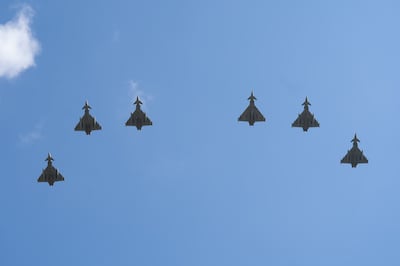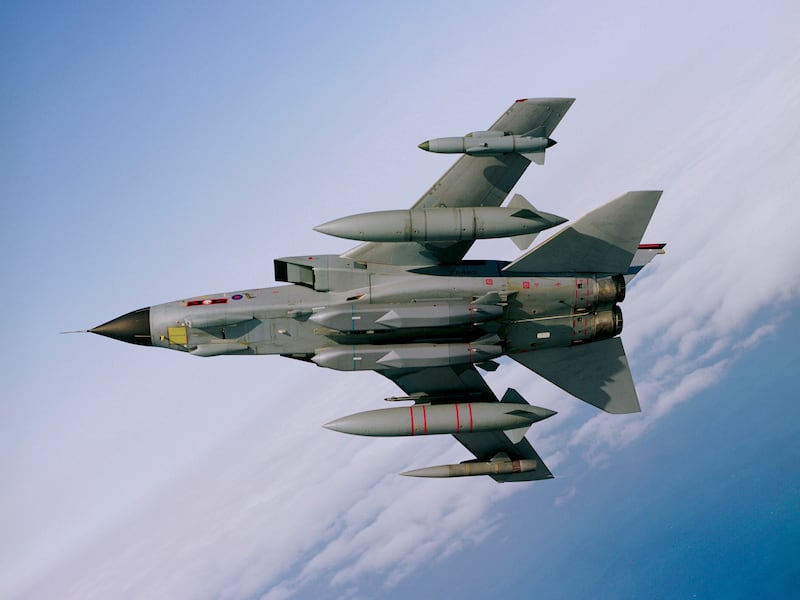Britain is looking to supply Ukraine with long-range cruise missiles that can penetrate thick concrete bunkers, a Ministry of Defence document has revealed.
The Storm Shadow missile, previously used in Iraq, is understood to be a leading contender in the effort to supply Kyiv with a weapon that can strike much farther behind Russian lines.
The ministry has launched an “urgent bidding round”, issuing a tender for a “long-range strike” capability from suppliers around the globe.
The specifications required are a range of between 100km and 300km, a payload between 20kg and 490kg and with the ability to be launched from land, sea or air.
It also requires the weapons to have a low probability of interception, pinpoint navigation in “the face of advanced countermeasures” and “air defence penetration”.
All those requirements fit neatly into MBDA’s Storm Shadow, which was first launched during the 2003 Iraq invasion and has been used effectively by the RAF against ISIS and during the 2011 Libya campaign.
When directly asked during an interview with the Atlantic Council in Washington on Tuesday if Britain should provide Ukraine with longer range missiles and F16 fighters, British Foreign Secretary James Cleverly's reply was that “giving them the tools they need to get the job done” was the priority.
Storm Shadow will prove a significant game changer for Ukraine giving it the capability to strike Russian command and control centres, logistics centres or hardened fighter pens in Crimea and elsewhere.
While it has been launched only from RAF Typhoon and Tornado jets, analysts believe that it would be relatively straightforward to mount it on to Ukraine’s MiG-29 or Su-27 combat aircraft.

Target Kremlin?
US-supplied Himars precision-guided missiles have been highly successful in degrading Moscow’s forces, but with a range of just 75km the Russians have been able to push their more valuable targets out of danger.
The US, however, is hesitant about providing Kyiv with longer range missiles, fearing that it could escalate the war into Russia itself.
Gen Ben Hodges, the former commander of US forces in Europe, told The National this year that the US should supply Ukraine with longer range missiles such as ATACMS, a pinpoint-accurate 1,700kg missile with a range of 300km.
Leaders should “quit worrying so much about, ‘Oh, my God, if we get an attack on this or hit a target in Crimea then the Russians might go to use a nuclear weapon’,” he said.
While it is understood that western powers would insist on a Kyiv guarantee that the missiles would not be used to strike Russia itself, there are fears that Storm Shadow could provoke a wider conflict.
“Storm Shadow could blow up the Kremlin and start World War Three,” said defence analyst Tim Ripley.
“This is taking the war to a different level, this is not defence of Ukraine, this is for actually hitting hard targets in Russia, which will generate a response."
He added that MBDA, an Anglo-French company, would have to step up production of the missile at its factories because it was unlikely the British military would donate Storm Shadow from its own war stocks and that was why it issued the tender.
The cost of the weapon, estimated at $2.5 million per missile, is another prohibitive factor. The International Fund for Ukraine, set up by Britain for weapon supplies, has $400 million left.
Deadly capabilities
Equipping Ukraine with Storm Shadow will give it a weapon that will significantly change Russia's military deployments, forcing their high value targets farther from the front line.
“Storm Shadow is capable of low level, terrain-following capability to specific targets, usually behind enemy lines,” said William Jardim, missile analyst at Janes, the defence intelligence company.
“It has a broach-penetrating warhead capable of penetrating approximately two to four metres of concrete and has been used to strike ammunition depots, radar sites and high value targets.”
While its ability to evade electronic countermeasures and ground defences was a “very much closely guarded secret” the weapon has a radar altimeter that allows it to fly as low as 10 metres “which makes it far harder to intercept”, Mr Jardim told The National.
A final decision on supplying the missile will be made on June 5, according to the tender document.
“We have invited industry suppliers to submit expressions of interest,” to provide long range missiles and other arms, the MoD said.







